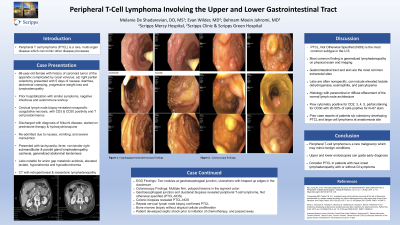Tuesday Poster Session
Category: General Endoscopy
P3435 - Peripheral T-cell Lymphoma Involving the Upper and Lower Gastrointestinal Tract
Tuesday, October 24, 2023
10:30 AM - 4:00 PM PT
Location: Exhibit Hall

Has Audio

Melanie H. De Shadarevian, DO, MS
Scripps Mercy Hospital
San Diego, CA
Presenting Author(s)
Melanie H. De Shadarevian, DO, MS1, Evan Wilder, MD2, Behnam Moein Jahromi, MD3
1Scripps Mercy Hospital, San Diego, CA; 2Scripps Green/Scripps Clinic, San Diego, CA; 3Scripps Clinic/Scripps Clinic Medical Group, San Diego, CA
Introduction: Peripheral T cell lymphoma (PTCL) is a rare, multi-organ disease that has various clinical manifestations. In this case, we present a 68-year old female thought to have histiocytic necrotizing lymphadenitis (Kikuchi disease), who was found to have esophageal, duodenal, and colonic peripheral T cell lymphoma.
Case Description/Methods: A 68-year-old female with a history of carcinoid tumor of the appendix causing cecal volvulus 6 years prior presented with 5 days of nausea, diarrhea, and abdominal cramping. The patient reported a twenty-eight pound weight loss with worsening of right-sided submandibular, preauricular, and cervical lymphadenopathy over two months. At prior hospitalization, the patient underwent extensive infectious and autoimmune workup for her lymphadenopathy, which was unremarkable. A cervical lymph node biopsy revealed coagulative necrosis, with CD3 and CD20 positivity and T cell predominance. The patient was presumptively diagnosed with Kikuchi disease, and discharged on prednisone therapy. She was started on hydroxychloroquine for maintenance therapy, however was re-admitted due to new gastrointestinal symptoms and severe malnutrition. Labs were notable for a high anion gap metabolic acidosis with elevated lactate, hyponatremia and hypoalbuminemia. Imaging revealed interaortocaval, retroperitoneal, mesenteric, hilar, mediastinal, and paratracheal lymphadenopathy. An EGD and colonoscopy were performed, and demonstrated two nodules at the gastroesophageal junction, ulcerations with heaped up edges in the duodenum, and multiple firm, polypoid lesions in the sigmoid colon. Biopsy specimens obtained revealed peripheral T cell lymphoma. Cervical lymph node biopsy confirmed PTCL. Bone marrow biopsy performed did not demonstrate atypical cellular proliferation. The patient developed septic shock prior to initiation of chemotherapy, and subsequently passed away.
Discussion: While lymphadenopathy is the most common manifestation of PTCL, the predominant extranodal sites include the gastrointestinal tract and skin. This patient presented with abdominal pain, cramping, nausea, and diarrhea with significant malnutrition and cachexia. Given the nonspecific, inflammatory findings on lymph node biopsy, a diagnosis of Kikuchi disease was made without further oncologic evaluation. Although lymph node dissection is the mainstay of diagnosis, prompt endoscopic evaluation may lead to earlier diagnosis in cases with nonspecific cytologic findings and gastrintestinal manifestations.

Disclosures:
Melanie H. De Shadarevian, DO, MS1, Evan Wilder, MD2, Behnam Moein Jahromi, MD3. P3435 - Peripheral T-cell Lymphoma Involving the Upper and Lower Gastrointestinal Tract, ACG 2023 Annual Scientific Meeting Abstracts. Vancouver, BC, Canada: American College of Gastroenterology.
1Scripps Mercy Hospital, San Diego, CA; 2Scripps Green/Scripps Clinic, San Diego, CA; 3Scripps Clinic/Scripps Clinic Medical Group, San Diego, CA
Introduction: Peripheral T cell lymphoma (PTCL) is a rare, multi-organ disease that has various clinical manifestations. In this case, we present a 68-year old female thought to have histiocytic necrotizing lymphadenitis (Kikuchi disease), who was found to have esophageal, duodenal, and colonic peripheral T cell lymphoma.
Case Description/Methods: A 68-year-old female with a history of carcinoid tumor of the appendix causing cecal volvulus 6 years prior presented with 5 days of nausea, diarrhea, and abdominal cramping. The patient reported a twenty-eight pound weight loss with worsening of right-sided submandibular, preauricular, and cervical lymphadenopathy over two months. At prior hospitalization, the patient underwent extensive infectious and autoimmune workup for her lymphadenopathy, which was unremarkable. A cervical lymph node biopsy revealed coagulative necrosis, with CD3 and CD20 positivity and T cell predominance. The patient was presumptively diagnosed with Kikuchi disease, and discharged on prednisone therapy. She was started on hydroxychloroquine for maintenance therapy, however was re-admitted due to new gastrointestinal symptoms and severe malnutrition. Labs were notable for a high anion gap metabolic acidosis with elevated lactate, hyponatremia and hypoalbuminemia. Imaging revealed interaortocaval, retroperitoneal, mesenteric, hilar, mediastinal, and paratracheal lymphadenopathy. An EGD and colonoscopy were performed, and demonstrated two nodules at the gastroesophageal junction, ulcerations with heaped up edges in the duodenum, and multiple firm, polypoid lesions in the sigmoid colon. Biopsy specimens obtained revealed peripheral T cell lymphoma. Cervical lymph node biopsy confirmed PTCL. Bone marrow biopsy performed did not demonstrate atypical cellular proliferation. The patient developed septic shock prior to initiation of chemotherapy, and subsequently passed away.
Discussion: While lymphadenopathy is the most common manifestation of PTCL, the predominant extranodal sites include the gastrointestinal tract and skin. This patient presented with abdominal pain, cramping, nausea, and diarrhea with significant malnutrition and cachexia. Given the nonspecific, inflammatory findings on lymph node biopsy, a diagnosis of Kikuchi disease was made without further oncologic evaluation. Although lymph node dissection is the mainstay of diagnosis, prompt endoscopic evaluation may lead to earlier diagnosis in cases with nonspecific cytologic findings and gastrintestinal manifestations.

Figure: A: Ulceration with heaped up edges at duodenal bulb
B: Two polypoid lesions at gastroesophageal junction
C: Multiple polypoid lesions throughout sigmoid colon
B: Two polypoid lesions at gastroesophageal junction
C: Multiple polypoid lesions throughout sigmoid colon
Disclosures:
Melanie De Shadarevian indicated no relevant financial relationships.
Evan Wilder indicated no relevant financial relationships.
Behnam Moein Jahromi indicated no relevant financial relationships.
Melanie H. De Shadarevian, DO, MS1, Evan Wilder, MD2, Behnam Moein Jahromi, MD3. P3435 - Peripheral T-cell Lymphoma Involving the Upper and Lower Gastrointestinal Tract, ACG 2023 Annual Scientific Meeting Abstracts. Vancouver, BC, Canada: American College of Gastroenterology.
